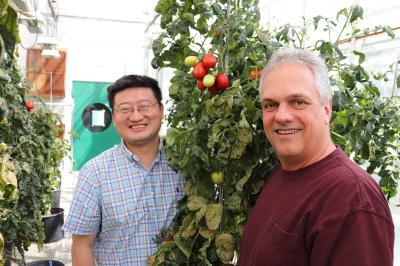Researchers from Boyce Thompson Institute published a tomato pan-genome in Nature Genetics, finding nearly 5,000 new genes and establishing a resource that promises to help breeders develop more flavorful and sustainable varieties

Credit: Photo by Mike Carroll
ITHACA, NY — Tomato breeders have traditionally emphasized traits that improve production, like larger fruits and more fruits per plant. As a result, some traits that improved other important qualities, such as flavor and disease resistance, were lost.
Researchers from Boyce Thompson Institute and colleagues from partnering institutions have created a pan-genome that captures all of the genetic information of 725 cultivated and closely related wild tomatoes, establishing a resource that promises to help breeders develop more flavorful and sustainable varieties.
As described in a paper published in Nature Genetics on May 13, the researchers found 4,873 new genes and identified a rare version of a gene that can make tomatoes tastier.
“The pan-genome essentially provides a reservoir of additional genes not present in the reference genome,” said BTI faculty member Zhangjun Fei. “Breeders can explore the pan-genome for genes of interest, and potentially select for them as they do further breeding to improve their tomatoes.”
The first tomato genome sequence was a large modern variety published in 2012, revealing approximately 35,000 genes and facilitating crop improvement efforts. Since then, several hundred additional tomato genotypes have been sequenced.
The current study is the first to mine all of these genome sequences–as well as another 166 new sequences generated by the researchers–to hunt for genes that were absent from the reference genome.
“During the domestication and improvement of the tomato, people mostly focused on traits that would increase production, like fruit size and shelf-life,” Fei said, “so some genes involved in other important fruit quality traits and stress tolerance were lost during this process.”
Indeed, the researchers found that genes involved in defense responses to different pathogens were the most common group of genes that were missing in the domesticated varieties of tomato.
“These new genes could enable plant breeders to develop elite varieties of tomatoes that have genetic resistance to diseases that we currently address by treating the plants with pesticides or other cost-intensive and environmentally unfriendly measures,” added James Giovannoni, a BTI faculty member and USDA scientist.
Giovannoni and Fei are co-corresponding authors on the paper and adjunct professors in Cornell University’s School of Integrative Plant Science.
In addition to recovering these “lost” genes, the researchers also analyzed the pan-genome to find genes and gene mutations that are rare among the modern cultivars.
This analysis identified a rare version of a gene, called TomLoxC, which contributes to a desirable tomato flavor. The rare version is present in 91.2% of wild tomatoes but only 2.2% of older domesticated tomatoes.
“The rare version of TomLoxC now has a frequency of 7% in modern tomato varieties, so clearly the breeders have started selecting for it, probably as they have focused more on flavor in the recent decades,” Giovannoni said.
The researchers also discovered a new role for the TomLoxC gene.
“TomLoxC appears, based on its sequence, to be involved in producing compounds from fats,” said Giovannoni. “We found it also produces flavor compounds from carotenoids, which are the pigments that make a tomato red. So it had an additional function beyond what we expected, and an outcome that is interesting to people who enjoy eating flavorful tomatoes.”
Ultimately, the tomato pan-genome could benefit the economy and the consumer, according to Clifford Weil, program director of the NSF’s Plant Genome Research Program, which supported the work.
“How many times do you hear someone say that tomatoes from the store just don’t quite measure up to heirloom varieties?” Weil asked. “This study gets to why that might be the case and shows that better tasting tomatoes appear to be on their way back.”
Tomatoes are one of the most consumed vegetables in the world–although technically we eat their fruit–with 182 million tons worth more than $60 billion produced each year. Tomatoes also are the second most-consumed vegetable in the U.S., with each American consuming an average of 20.3 pounds of fresh tomatoes and 73.3 pounds of processed tomatoes each year.
Researchers from the University of Florida, Cornell, the U.S. Department of Agriculture, the Pennsylvania State University, the Polytechnic University of Valencia, the University of Georgia and the Chinese Academy of Agricultural Sciences also participated in the study.
This research was supported by grants from the U.S. National Science Foundation, the European Research Area Network for Coordinating Action in Plant Sciences, the USDA-ARS and the U.S.-Israel Binational Agricultural Research and Development Fund.
###
Media kit with related photos, videos and logos:
http://bit.
Media Relations Contacts: AJ Bouchie (607-288-2578, [email protected]) or Stephanie Meyer ([email protected]).
Communications Office
Boyce Thompson Institute
533 Tower Road
Ithaca, New York 14853 USA
To learn more about Boyce Thompson Institute (BTI) research, visit the BTI website at BTIscience.org.
Connect online with BTI through Twitter and Facebook
About Boyce Thompson Institute:
Boyce Thompson Institute is a premier life sciences research institution located in Ithaca, New York on the Cornell University campus. BTI scientists conduct investigations into fundamental plant and life sciences research with the goals of increasing food security, improving environmental sustainability in agriculture and making basic discoveries that will enhance human health. Throughout this work, BTI is committed to inspiring and educating students and to providing advanced training for the next generation of scientists. For more information, visit BTIscience.org.
Media Contact
AJ Bouchie
[email protected]



